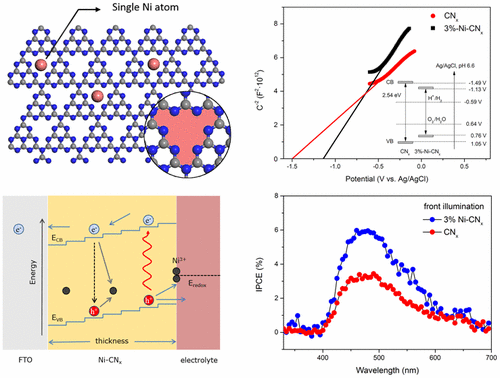当前位置:
X-MOL 学术
›
ACS Appl. Mater. Interfaces
›
论文详情
Our official English website, www.x-mol.net, welcomes your
feedback! (Note: you will need to create a separate account there.)
One-Pot Synthesis of Nickel-Modified Carbon Nitride Layers Toward Efficient Photoelectrochemical Cells
ACS Applied Materials & Interfaces ( IF 8.3 ) Pub Date : 2017-09-18 00:00:00 , DOI: 10.1021/acsami.7b08022 Wenyao Zhang 1, 2, 3 , Josep Albero 4 , Lifei Xi 5 , Kathrin M. Lange 5 , Hermenegildo Garcia 4 , Xin Wang 2 , Menny Shalom 1
ACS Applied Materials & Interfaces ( IF 8.3 ) Pub Date : 2017-09-18 00:00:00 , DOI: 10.1021/acsami.7b08022 Wenyao Zhang 1, 2, 3 , Josep Albero 4 , Lifei Xi 5 , Kathrin M. Lange 5 , Hermenegildo Garcia 4 , Xin Wang 2 , Menny Shalom 1
Affiliation

|
A new method to significantly enhance the photoelectrochemical properties of phenyl-modified carbon nitride layers via the insertion of nickel ions into carbon nitride layers is reported. The nickel ions are embedded within the carbon nitride layers by manipulating the interaction of Ni ions and molten organic molecules at elevated temperature prior to their condensation. A detailed analysis of the chemical and photophysical properties suggests that the nickel ions dissolve in the molten molecules, leading to the homogeneous distribution of nickel atoms within the carbon nitride layers. We found that the nickel atoms can alter the growth mechanism of carbon nitride layers, resulting in extended light absorption, charge transfer properties, and the total photoelectrochemical performance. For the most photoactive electrode, the Ni ions have an oxidation state of 2.8, as confirmed by soft X-ray absorption spectroscopy. Furthermore, important parameters such as absorption coefficient, exciton lifetime, and diffusion length were studied in depth, providing substantial progress in our understanding of the photoelectrochemical properties of carbon nitride films. This work opens new opportunities for the growth of carbon nitride layers and similar materials on different surfaces and provides important progress in our understanding of the photophysical and photoelectrochemical properties of carbon nitride layers toward their implantation in photoelectronic and other devices.
中文翻译:

一锅法合成镍修饰的氮化碳层以形成高效的光电化学电池
报道了一种通过将镍离子插入到氮化碳层中来显着增强苯基改性的氮化碳层的光电化学性质的新方法。通过控制镍离子和熔融有机分子在凝结之前在升高的温度下的相互作用,将镍离子嵌入到氮化碳层中。对化学和光物理性质的详细分析表明,镍离子溶解在熔融分子中,导致镍原子在氮化碳层内均匀分布。我们发现镍原子可以改变氮化碳层的生长机理,从而导致延长的光吸收,电荷转移性质以及总的光电化学性能。对于最具光活性的电极,如通过软X射线吸收光谱法所证实的,Ni离子具有2.8的氧化态。此外,还对吸收系数,激子寿命和扩散长度等重要参数进行了深入研究,为我们对氮化碳膜的光电化学性质的理解提供了实质性的进展。这项工作为氮化碳层和类似材料在不同表面上的生长开辟了新的机遇,并为我们理解氮化碳层在光电子和其他设备中的植入提供了重要的进展,帮助我们了解氮化碳层的光物理和光电化学特性。为我们对氮化碳膜的光电化学性能的理解提供了实质性的进展。这项工作为氮化碳层和类似材料在不同表面上的生长开辟了新的机遇,并为我们理解氮化碳层在光电子和其他设备中的植入提供了重要的进展,帮助我们了解氮化碳层的光物理和光电化学特性。为我们对氮化碳膜的光电化学性能的理解提供了实质性的进展。这项工作为氮化碳层和类似材料在不同表面上的生长开辟了新的机遇,并为我们理解氮化碳层在光电子和其他设备中的植入提供了重要的进展,帮助我们了解氮化碳层的光物理和光电化学特性。
更新日期:2017-09-18
中文翻译:

一锅法合成镍修饰的氮化碳层以形成高效的光电化学电池
报道了一种通过将镍离子插入到氮化碳层中来显着增强苯基改性的氮化碳层的光电化学性质的新方法。通过控制镍离子和熔融有机分子在凝结之前在升高的温度下的相互作用,将镍离子嵌入到氮化碳层中。对化学和光物理性质的详细分析表明,镍离子溶解在熔融分子中,导致镍原子在氮化碳层内均匀分布。我们发现镍原子可以改变氮化碳层的生长机理,从而导致延长的光吸收,电荷转移性质以及总的光电化学性能。对于最具光活性的电极,如通过软X射线吸收光谱法所证实的,Ni离子具有2.8的氧化态。此外,还对吸收系数,激子寿命和扩散长度等重要参数进行了深入研究,为我们对氮化碳膜的光电化学性质的理解提供了实质性的进展。这项工作为氮化碳层和类似材料在不同表面上的生长开辟了新的机遇,并为我们理解氮化碳层在光电子和其他设备中的植入提供了重要的进展,帮助我们了解氮化碳层的光物理和光电化学特性。为我们对氮化碳膜的光电化学性能的理解提供了实质性的进展。这项工作为氮化碳层和类似材料在不同表面上的生长开辟了新的机遇,并为我们理解氮化碳层在光电子和其他设备中的植入提供了重要的进展,帮助我们了解氮化碳层的光物理和光电化学特性。为我们对氮化碳膜的光电化学性能的理解提供了实质性的进展。这项工作为氮化碳层和类似材料在不同表面上的生长开辟了新的机遇,并为我们理解氮化碳层在光电子和其他设备中的植入提供了重要的进展,帮助我们了解氮化碳层的光物理和光电化学特性。











































 京公网安备 11010802027423号
京公网安备 11010802027423号